In the ever-evolving landscape of football management, the appointment of Erik ten Hag as the head coach of Manchester United has sparked an intense discourse among fans and pundits alike. Renowned for his tactical and meticulous approach to the game, ten Hag brings lots of experience and innovation to the iconic club. As the Red Devils embark on a new chapter under his stewardship, this tactical analysis aims to dissect the strategic nuances and game-changing approaches that define Ten Hag’s managerial philosophy. From build-up strategies to defensive organization, join us as we delve into the tactical intricacies shaping Manchester United’s journey under Erik ten Hag.
Build-up
Low Build-up
Erik Ten Hag sets his team up in a 1-4-2-1-3 formation in the low build-up, positioning the front three centrally.


Having the wingers centrally opens the space out wide for the fullbacks to push up. When the fullbacks push up, the center-backs can come wider. This allows the goalkeeper to push up between the center-backs, creating a back-three. The goalkeeper, Onana, will often come up to create this back-three and find long balls aimed at the wingers or fullbacks.

High Build-up
In the high build-up, Ten Hag’s Manchester United rotates into a 1-3-2-5 formation:


They usually rotate into this formation by pushing one fullback into the midfield and one into the backline, or pushing both fullbacks up and dropping with a holding midfielder.
Having four central midfielders(two holding and two attacking) creates more options in the center and less space between the players. Ten Hag likes this because he prioritizes playing through the middle. He needs one player high and wide to pull apart the backline while the rest create numerical advantages in the midfield areas. This builds good conditions in defensive transitions, allowing more players to press when they lose the ball. Another purpose for keeping many players in the middle is to shorten the distance between them. This shortens the length of the passes, which naturally shortens the time between passes. This means the opposition players will have less time to push up and press, giving the United players more time and control.
High Backline
A massive aspect of Man United’s high build-up is they keep a high backline. This helps in the counter-press because they get more players closer to the center. Having more players close to the center who can win the ball back makes it difficult for the opposition to do anything when they win possession. Furthermore, the high backline shortens the distance between players, shortening the time and length of the passes and preventing the opposition from pushing up their defense.

Rotations and Interchanges
One influential principle in Ten Hag’s playing style is to be fluid within the system and to find different interchanges and rotations. These rotations confuse the opposition because they do not know whether they should follow the United players or stay in their position. A big part of Man United’s fluidity is that everyone can play everywhere. Here, Wan-Bissaka comes into a striker position from his left-back position, which gives the opposition questions to answer.
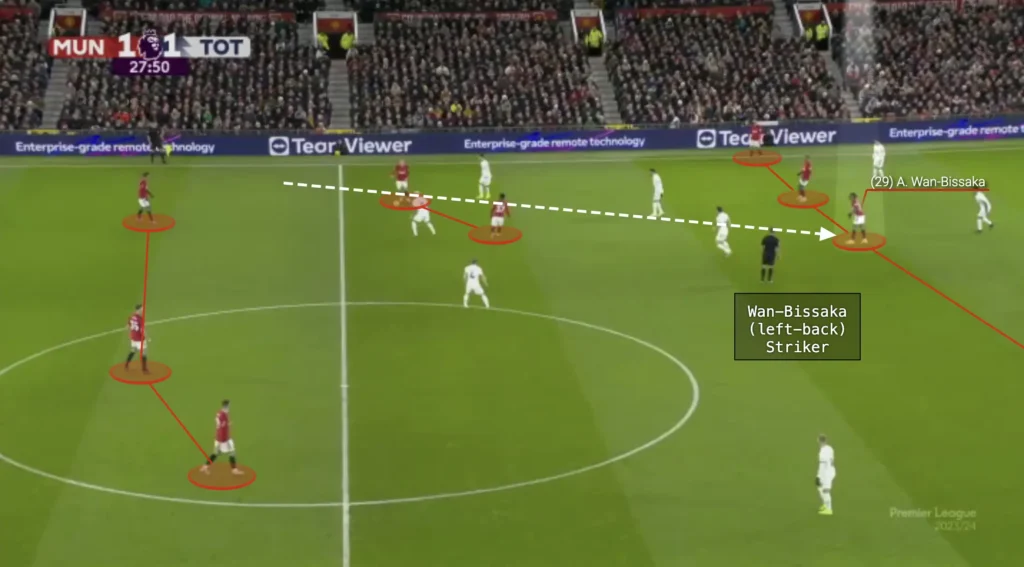
Finding the Pockets
Man United always try to find the attacking midfielders in the pockets. Their midfield numerical superiority usually means that at least one will be open. They will look for passes from the back or the wing, breaking lines and finding an attacking midfielder who will turn and drive at the defense.
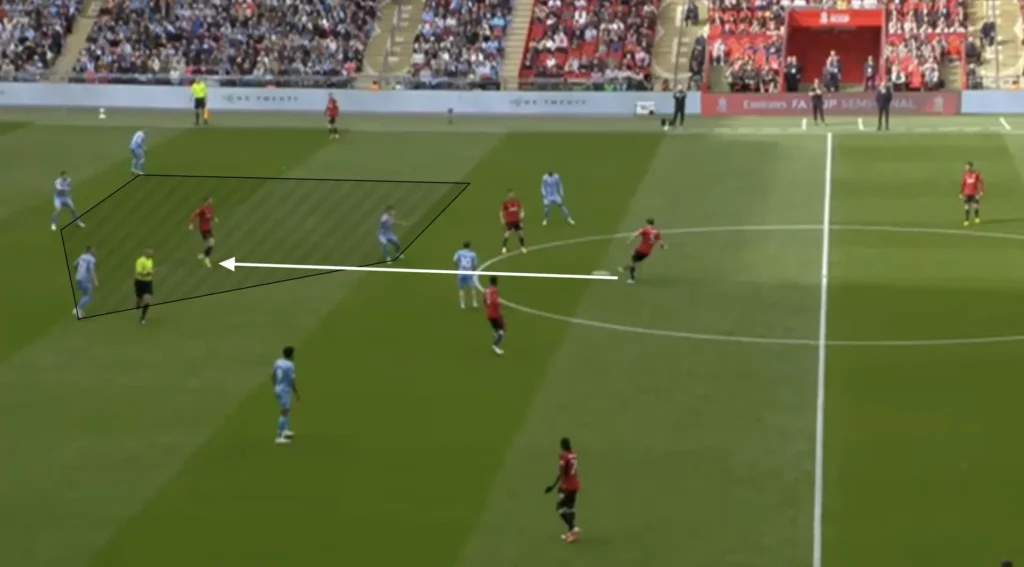

Center-back Movement
Manchester United have a unique movement with their center-backs. When the center-back passes the ball to the fullback, he often makes a continuing run up behind the opposition winger.

The opposition winger will press the fullback, which opens the space behind him, the space that the center-back is running into. The ball can be played to the center-back, who will have the time and space to turn and progress the ball forward.

Balls in Behind
Man United do not shy away from using the early through-ball in behind the opposition’s backline. The attackers constantly make runs in behind when the United midfielders or defenders have the ball. This constant threat prevents the opposition from playing with a high backline and closing the space between the lines. Instead, they have to drop the backline and protect the space in behind, opening the space in the middle for the Man United midfielders to exploit.


Numerical Advantages
Another massive aspect of Man United’s high build-up is their ability to create numerical advantages against the opposition’s defensive line. Their front five naturally becomes numerically superior against a back four, which they are great at taking advantage of.
When the defending team is positioned on one side, the weak-side fullback becomes vulnerable to the long switch of play due to the 1v2 against Ipswich’s winger and attacking midfielder. Ten Hag’s team often capitalizes on this by getting the ball to the winger and creating many opportunities from 2v1 situations on the wing and in the half-spaces.

Final Third
Attacking the Half-Space
Man United is a great team in the final third. They always create many chances, mainly by attacking the space between the opposition center-back and fullback. They primarily do this from the wide areas with underlaps from the attacking midfielders or sometimes the fullbacks.


The winger can either play the ball to the underlapping player, who can cross to a teammate in the box, or take the ball inside to combine with an attacker or shoot.
Ten Hag’s team also exploits the space between the center-back and the fullback by playing through-balls from the midfield or backline to a running winger or number-eight.
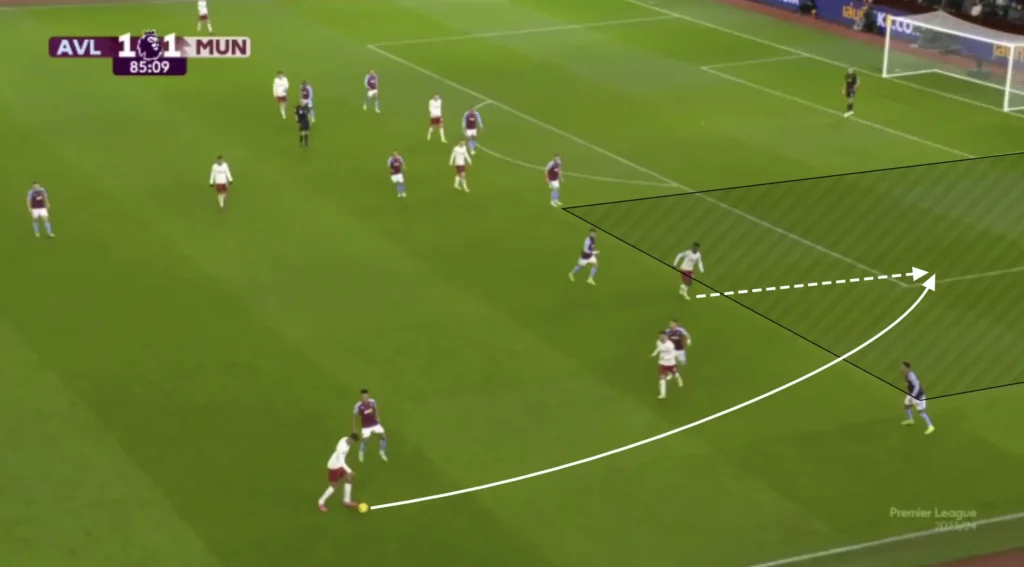
Overlaps
Man United also uses overlaps to produce opportunities in the final third. When the winger gets the ball, a United player quickly makes the overlap, creating a 2v1 on the wing. If the opposition fullback drops to cover the overlapping run, the winger could cut inside, taking a shot or combining with a midfielder. If the fullback covers the center, the ball can easily be played to the overlapping player, creating a crossing opportunity.

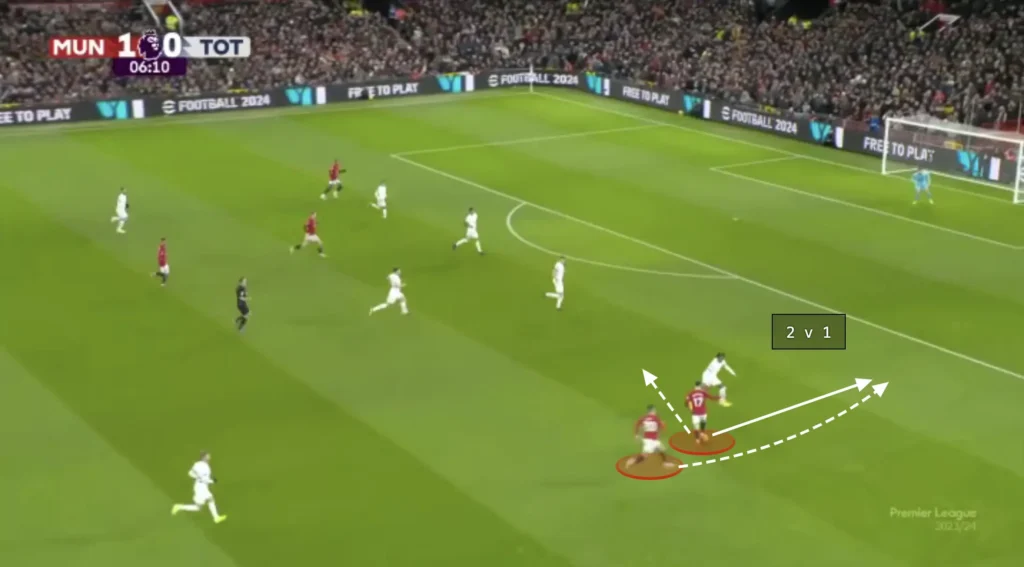
Many Players in the Box
The attacking midfielders and wingers always look to make runs into the box when the ball is in the final third, often getting four or five players into these areas to create overloads. The numerical advantages in the box force the defending team to make decisions and leave some players open.

Ten Hag also positions many United players outside the box, ready for the second balls and cut-backs. They always succeed in pushing down the opposition’s defense, which opens the space in front of the backline. United will often find their midfielders in these spaces, who can shoot or combine with an attacker to create goalscoring opportunities.
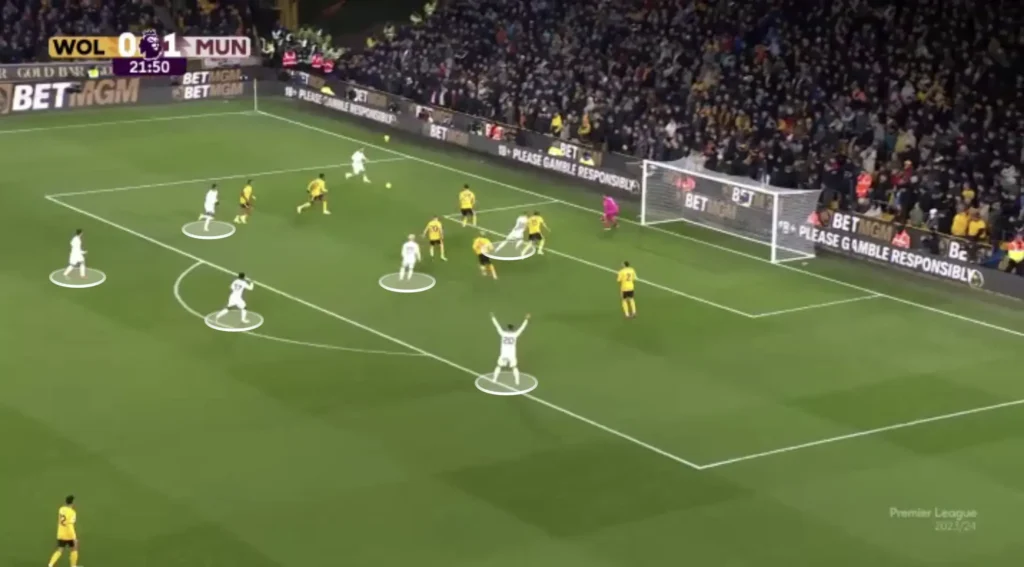

Defending
High Press
Ten Hag places much value in being aggressive without the ball. This shows in Man United’s high pressure. Ten Hag usually wants his team to go man-to-man and intensely press the opposition.


They almost use their high press as an attacking threat, scoring many goals from winning the ball in their high press.
Low Press
Ten Hag’s Man United uses a 1-4-4-2 formation in the low press. They look to set up in a mid-block, always trying to close the center, forcing the opposition out wide.

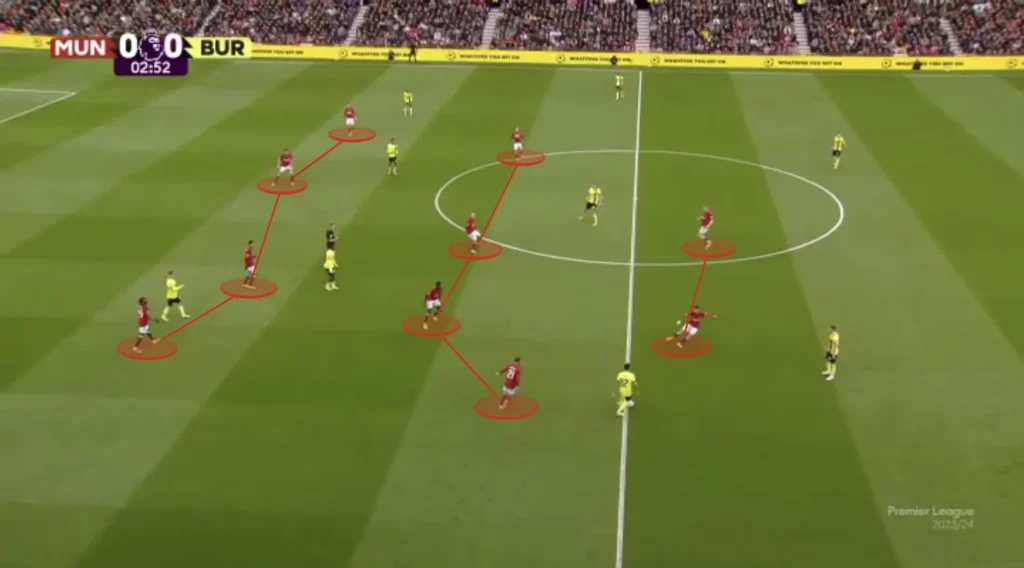
Man United always look to squeeze the pitch when defending. This means constantly pushing the team up as much as possible. Every time the opponent plays a slow, sideways pass or a back pass, United’s first line of pressure pushes up, with the rest of the team following to stay compact. When the next pass comes, they push up even more, forcing the opponent back even more. They do this because it pushes the opponent further away from the United goal, making it harder to create chances.

Transitions
Defensive Transitions
Positioning many players centrally, creating a numerical advantage in the midfield, creates good conditions in defensive transitions. Many players close to the ball after losing possession means that many players can work towards regaining possession. Therefore, Man United often successfully regains possession directly after losing it.
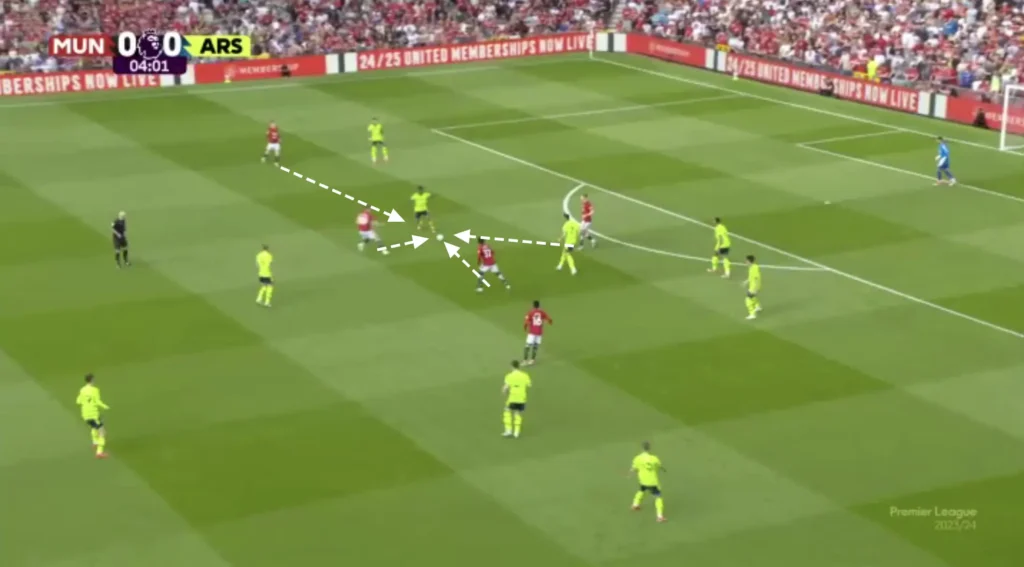

Offensive Transitions
Ten Hag also wants his team to counterattack in their offensive transitions. They do this with a high tempo, often attacking the spaces between the center-backs and fullbacks. In addition, keeping many players centrally while defending enables them to incorporate more players into the counterattacks.

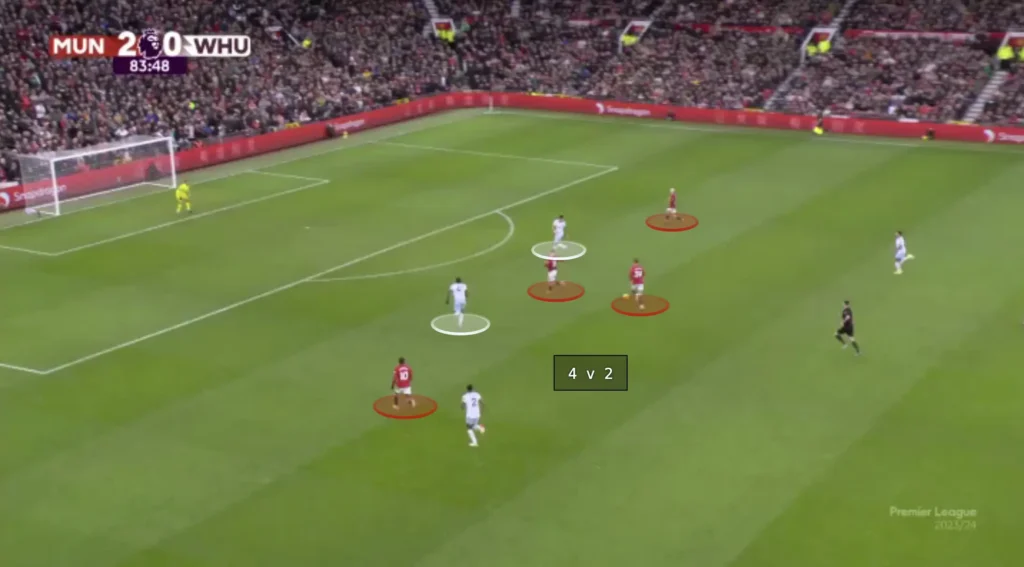
Problems
Unity
The biggest problem with the current Man United side is the lack of synergy and unity. To be a successful team, the players must all have the same view of what they should do in different situations. Some players have one opinion while others have a different opinion, creating confusion and problems for Man United.
In this situation, the goalkeeper, Onana, has the ball and is being pressured by the Arsenal striker. Casemiro is dropping into the space that the striker has left open and Amrabat is dropping, wanting to receive a pass from Onana to play the ball to the open Casemiro. The other Man United players, however, are not dropping and are instead pushing up to be ready for a long ball.
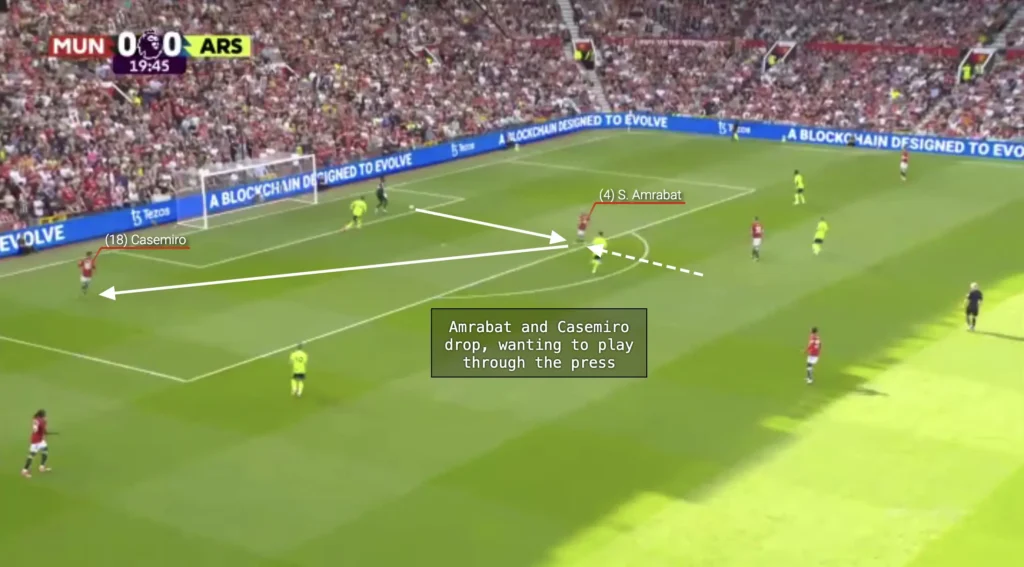
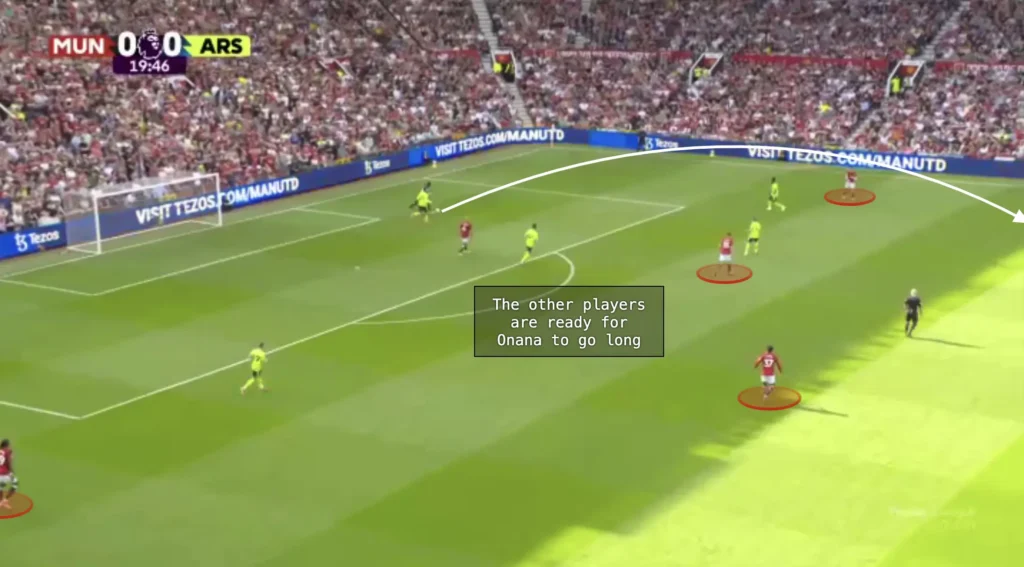
Onana goes for the long option, where Man United lose the ball. Because Casemiro wanted to play through the Arsenal press, he was positioned very low and was, therefore, very late to get back in line with the rest of the backline. This allows Arsenal to pass the ball to Havertz, who is not offside because of Casemiro’s positioning.
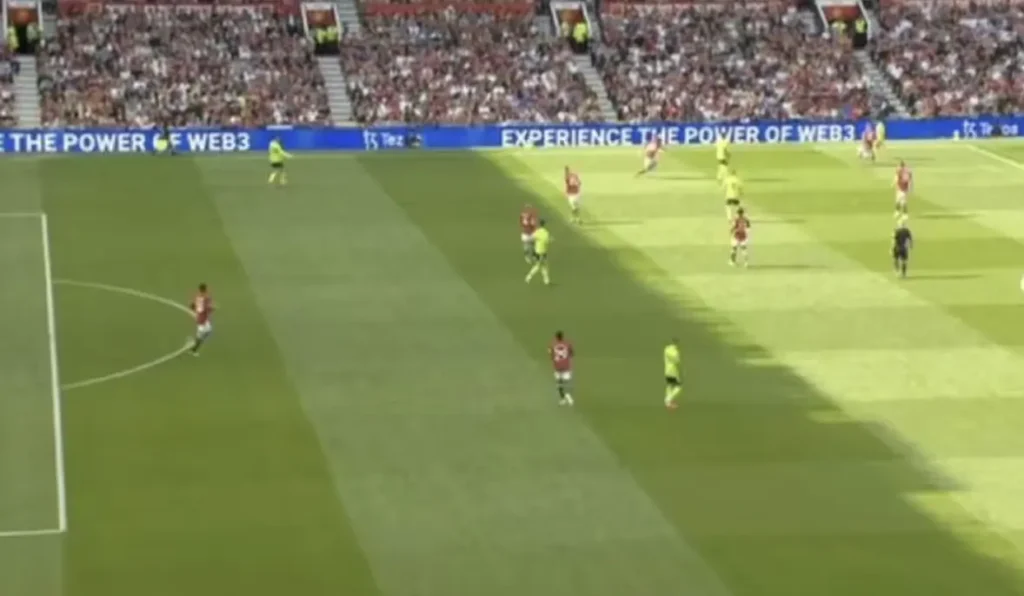
The rest of the backline is beaten by this pass, which enables Havertz to drive into the open space and assist Trossard for an Arsenal goal. In this situation, Man United could have played past the press, like Amrabat and Casemiro wanted to, or they could have gone long like the others wanted. The important thing is that everyone is on the same page about which solution they are going for. When they go long, Casemiro is so far behind the rest of the backline that he does not have the time to push up and put Havertz offside, which leads to United conceding a goal.
Communication
Here is another situation where Man United’s lack of synergy and communication shows. There is one Bournemouth player positioned in the pocket and three United players very close to him. Despite this, the Bournemouth player is completely open and will receive a pass, turn, and attack the defense, leading to a Bournemouth goal.

The United players have to know who should mark him, but it is evident that they do not know. If they do not know, they have to communicate with each other to figure out what to do. Now, there is no communication, which leads to no one marking him, allowing him to turn and create a goal for Bournemouth.
Final Thoughts
In closing, this tactical analysis of Manchester United under the stewardship of Erik Ten Hag offers a glimpse into the strategic evolution of one of football’s most storied clubs. Ten Hag’s meticulous approach to the game is evident in the team’s structured build-up and incisive attacking play.
The nuances of Manchester United’s tactical setup highlight Ten Hag’s emphasis on positional play, pressing triggers, and transitional fluidity. The implementation of a flexible formation, combined with the intelligent movement of players, underscores Ten Hag’s commitment to unlocking opposition defenses while maintaining defensive stability.
As Manchester United continues its journey under Ten Hag’s guidance, the tactical insights gleaned from this analysis serve as a roadmap for the team’s progression. With Ten Hag at the helm, United fans can expect a blend of innovation and tradition, as the club strives to reclaim its position among Europe’s elite.




